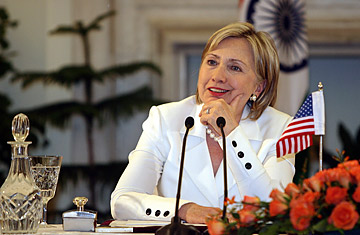
Secretary of State Hillary Clinton
U.S. Secretary of State Hillary Clinton's four-day visit to India was a whirlwind expedition packed with meetings with the country's top leadership and a range of industry and civil-society representatives as well as sundry public addresses. The message Clinton sought to deliver was clear: the Obama Administration wants to carry forward the momentum in bilateral relations gathered during the George W. Bush years, especially pertaining to nuclear and defense cooperation, but also on issues ranging from education and agriculture to health and women's rights. She also indicated the Administration's intention of supporting India as it readies to play a bigger role in regional and global affairs. But as a near war of words over climate change showed, there is much ground to cover between rhetoric and reality, and the fledgling "strategic partnership" is not likely to be an easy one.
The big takeaways of Clinton's visit are three key agreements. The first is an "end-use monitoring" agreement that allows the U.S. to track arms supplied to India to ensure that they are not sold or otherwise given to third parties. This agreement, required by U.S. law, enables U.S. companies to sell high-tech military equipment and technology to India, immediately benefiting Boeing and Lockheed Martin, which will be able to bid for contracts to supply 26 fighter jets to India for a $10 billion deal.
The second, a technical-safeguards agreement, will enable India to launch non-commercial satellites containing U.S. components, while an agreement to set up a science-and-technology endowment fund will allow more cooperation in those fields.
In addition to the monetary boost for U.S. businesses and the ego boost for India, a "strategic dialogue" encompassing a range of subjects — from soft issues like education to thorny ones such as climate change, terrorism and nuclear non-proliferation — was announced. Clinton's speeches and interviews to the local media were full of references to India's greater role on the global stage. "[I] consider India not just a regional but global power," she told an Indian news channel on July 18, the day after she arrived in Mumbai. The irony of that statement was not lost on India's foreign policy set, given that the country's recent attempts to take a leadership role in international affairs, such as leading developing nations at the World Trade Organization (WTO) and in climate-change negotiations, has led it on a path of friction with the U.S.
In fact, the Indian Environment Minister, Jairam Ramesh, broke away from the saccharine tone of most of Clinton's meetings with the country's leaders by bluntly reiterating India's position that it would not accept binding emissions cuts. "There is simply no case for the pressure that we, who have been among the lowest emitters per capita, face to actually reduce emissions," Ramesh said to Clinton at a conference on climate change in Gurgaon, near New Delhi, on July 19. "And as if this pressure was not enough, we also face the threat of carbon tariffs on our exports to countries such as yours." Clinton defused the situation by asserting that the U.S. would not take any step to limit India's economic growth.
"The U.S. is keen to emphasize India's responsibilities," says New Delhi–based strategic-affairs analyst Brahma Chellaney. "On NPT [non-proliferation treaty], on climate change, the attempt is to see what India can do. But the U.S.'s own policies in this regard have been high on rhetoric and low on action." Ever since India and the U.S. first decided to put aside Cold War–era mistrust and start taking baby steps toward a friendship powered by a shared distrust of China and a common commitment to democracy, skeptics have warned that mutual interests do not naturally coalesce.
This has been made amply clear during negotiations over the non-proliferation treaty, climate change and manufactured-goods tariffs at the WTO. The limits of mutual interests are also striking when it comes to dealing with other countries such as Iran — with whom India is planning a gas pipeline — and Burma, whom India has been supplying with aid and military hardware in return for access to its gas fields.
At the same time, while India hopes to be a global power, it has failed to articulate a strong position — let alone take a leadership role — even in its immediate neighborhood, whether on Sri Lanka or on Afghanistan, which has a direct bearing on Islamist terrorism in all of South Asia. "For this, India's foreign policy establishment needs to change," says Dipankar Banerjee, director of the Institute for Peace and Conflict Studies in New Delhi. "There are structural limitations, but that's changing. There is greater realization and willingness to discuss regional issues." Former diplomat Rajiv Sikri agrees: "We need a more activist agenda of our own. Next time, we should not merely react to what the U.S. puts on the table. We must be in a position to say, 'Look, we want to talk about this.' " The irony of the Indo-U.S. strategic partnership remains that while the U.S. may urge India to become a global power, neither country is ready for that to happen.
